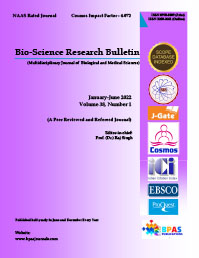Integrated Management of Root Knot Disease Complex of Brinjal by Using Fungal Bioagent
DOI:
https://doi.org/10.48165/Keywords:
Antagonist, disease complex, Host tolerance, fungal biogents, Glomus fasciculatumAbstract
In systematic survey a disease complex was found which caused disease complex resulting in heavy damage of brinjal crop caused by root knot nematode Meloidogyne incognita and root will fungus Fusarium oxysporum f. sp. lycopersici. Sevral sprophytic fungi were found associated with the rhizosphere soil viz. Trichoderma hazarium, Aspergillus terreus, A. fumigatus, A. niger, Cladosporium oxysporum, Penicillium oxalium, Aspergillus species which was not egg parasitic but exihibited high toxicity (85-100%) to second stage juveniles (J2), C. oxysporum parasitized the egg by 84% but in effective against J2, while the eggs and juveniles of M. incoginita get effected by T. hazarium by 80% and 72% respectively. The soil is amendment of vasicular mycorrhiza by talc based formulation of T. hazarium @8g Kg -1 (2×106 spore load) along with leaf powder (0.05% w/w) of Tinospora longifolia and vasicular arbuscular mycorrhiza (Glomus fasciculatum) @ 100 chlamydospore per kg soil.
References
Abawi GS, Barker KR, 1984. Effect of cultivavar, soil temprature and population level of Melidogyne incognita on root necrposis and Fusarium wilt of tomatoes. Phytopathaology. 74, 433-8
Batten CK and Powell NT (1970) The Rhizoctonia- Melidogyne incognita disease complex in flue caused tobacco. J Nematol 3 : 164-169
Bansal, R.K.; Walia, R. K. and Bhatti,D.S. (1992). Wood charcoal powder, a carrier of Paecilomyces lilacinus spores. Nematol. Medit.20: 5-7
Bhagawati B, Goswami, BK and Singh CS (2000) Management of disease complex of tomato caused by Moledogyne incognita and fusarium oxysporum f.sp. lycopersici through bioagents. Indian J Nematol 30 (1) : 16-22.
BK and Goswami BK (2000) Interrelationships meloidogyne incognita and fusarium oxysporum f.persici on tomato. Indian J Nematol 31(1) : 93-94
BK and Vijayalakshmi K (1986) Efficacy of some ous plant materials and non-edible oil-edible of seed cakes Meloidogyne incognita on tomato. Indian J Nematod 280-281.3
Desai MV, Shah HM and Pillai SM (1972) Effect of Aspergillus niger on root-knot nematode, jMeloidogyne incognita. Indian J Nematol 2 : 210-214.
Devi Pramila and Goswami BK (1992) Effect of VA mycorrhiza, Glomus fasciculatum on disease incidence due to cause by the interaction of Meloidogyne incognita and Macrophomina phaseolina on cowpea. Ann Agric Res 13(3) : 253-256.
Elad Y, Chet I and Kaman J (1980) Trichoderma harzianum: A biocontrol agent effective against scferotium rolfsill and Rhizoontania solani PHyonathi 70: 119-121.
F.A.O.,(1995). Food and Agricultural Organisation-Production Year book. Volume 49. FAO, Rome,p.p. 130
Goswami BK and Satyendra Singh (2002) Effect of Aspergillus niger and Cladosporium oxysporum on root-know nematode (Meloidogyne incognita) multiplication on egg plant. Indian J Nematol 32 (1) : 98-101
JK sand Vangundy SD (1975) Disease complex of tomato involving the nematode, Meloidogyne and the soil inhabiting fungus Rhizoctonia solani, thol 65 : 265-273. 13. Khan MR and Goiswami BK (2001) Cladosporium oxysporum an egg parasitic nematophagous fungus of Melodogyne incognita India J Nematol 31 (2) : 168-170. 14. Pandey RK, Goiswami BK and Singh S (2005) Management of disease complex by root-knot nematode and wift fungus thgough fungal bioagent, neem oil seed cakes and/or VA mycorhiza on chick pea. International Newssletter of Chickpea and Pigeonpea 12:32-34. 15. PPS and Chabra HK (1984) Interaction of Melidogyne incognita with Rhizoctonia on
tomato, Indian J 14: 56-57
Powell,N.T.; and Nusbaum Interaction between nematodes, fungi in complex. Ann Rev phytopath 9:253-274.
Scardo, P.A.(1886). Sylloge Fungorum. 4:705
Thorne, G. (1961). Principles of Nematology. MORGRAW HILL BOOK COY, INC. 1-553 19. Uppal, B.N., Patel, M.K. and Kmat, M.M. (1934). The fungi of Bombay Dept: Agric. (Bombay) 20. Zuckermann BM, Mathny M and Acosta N (1994) Control of plant parasitic nematode by a nematicidal strain of Aspergillus niger. J Chem Ecol 20: 33-43.
